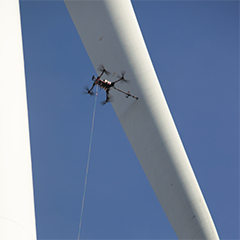Fast, precise… cost-effective
After the media hype, it’s time to confirm it: the UAV is a formidable tool at the service of the wind power industry. SupAirVision is inventing and developing new uses for the UAV to meet the needs of the wind industry: inspection, painting and test of the lightning protection system (LPS).
‘The capabilities of UAVs have evolved incredibly in a decade. They have improved in reliability, load capacity and above all, flight precision and stability,’ says Sébastien Arnould, founder & CEO of SupAirVision – UAV wind power services. Nowadays, it is possible to fly within a few metres of a wind turbine’s blades with great precision, and even touch them to test the lightning path or to carry heavy loads such as high-precision sensors. ‘For the wind industry, the UAV is an incredible tool that allows access to the blades or the outside of the nacelle without leaving the ground.
The multi-rotor was born out of the miniaturisation of electronics
As is often the case, it was the army that paved the way… in 1917. A pioneer in aviation, the French army was also behind the invention of the first unmanned aerial vehicle (UAV: Unmanned Aerial Vehicle), which took off for the first time from the military base at Avord. On 2 July 1917 the Frenchman, Max Boucher, successfully took an unmanned aircraft for a flight of 500 metres, at 50 metres above ground level. The challenge at the time was a major one: to create a machine capable of carrying out reconnaissance missions without risking the lives of the pilots. Unfortunately, the technology used on these radio-controlled aircraft was still far too rudimentary for research to be pursued on a large scale.
During the cold war, advances in automation and radio communications enabled the US Air Force to invest in this field. Over the years, as technology evolved, models were perfected, leading to the multi-rotor UAV currently used in inspection.
























